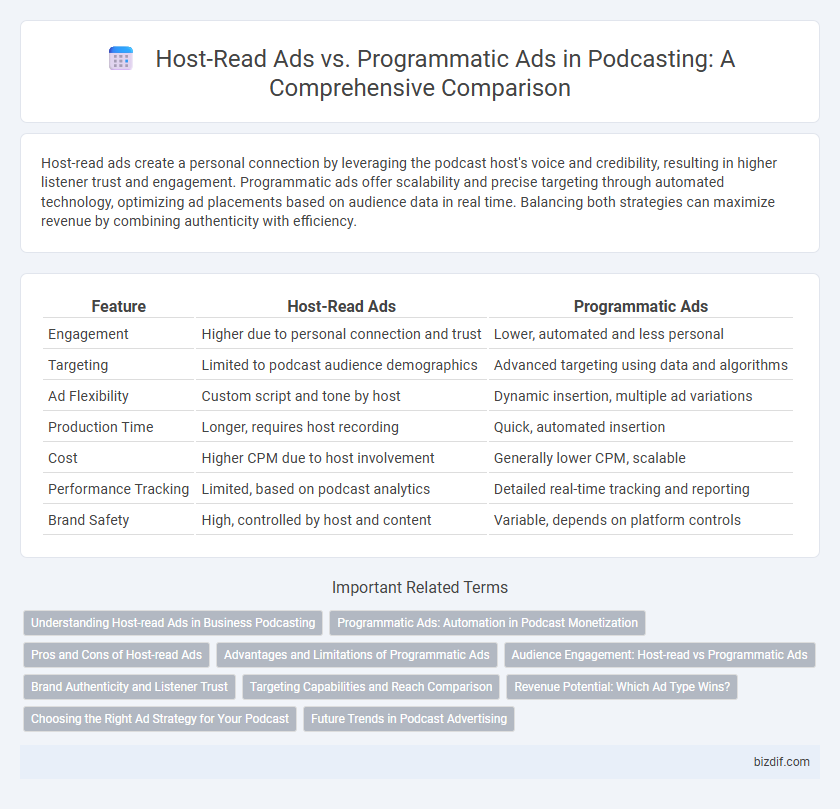Host-read ads create a personal connection by leveraging the podcast host's voice and credibility, resulting in higher listener trust and engagement. Programmatic ads offer scalability and precise targeting through automated technology, optimizing ad placements based on audience data in real time. Balancing both strategies can maximize revenue by combining authenticity with efficiency.
Table of Comparison
| Feature | Host-Read Ads | Programmatic Ads |
|---|---|---|
| Engagement | Higher due to personal connection and trust | Lower, automated and less personal |
| Targeting | Limited to podcast audience demographics | Advanced targeting using data and algorithms |
| Ad Flexibility | Custom script and tone by host | Dynamic insertion, multiple ad variations |
| Production Time | Longer, requires host recording | Quick, automated insertion |
| Cost | Higher CPM due to host involvement | Generally lower CPM, scalable |
| Performance Tracking | Limited, based on podcast analytics | Detailed real-time tracking and reporting |
| Brand Safety | High, controlled by host and content | Variable, depends on platform controls |
Understanding Host-read Ads in Business Podcasting
Host-read ads in business podcasting create authentic connections by leveraging the host's trusted voice and deep understanding of the audience, resulting in higher engagement and conversion rates compared to programmatic ads. These ads integrate seamlessly into the episode content, making them less intrusive and more persuasive by aligning with the podcast's tone and subject matter. Brands benefit from enhanced credibility and targeted messaging through the personalized delivery that only host-read ads can provide.
Programmatic Ads: Automation in Podcast Monetization
Programmatic ads leverage automation to optimize podcast monetization by enabling real-time bidding and dynamic ad insertion, increasing efficiency and targeting precision. Utilizing machine learning algorithms, programmatic platforms adjust ad delivery based on listener data, maximizing revenue potential without manual intervention. This scalable approach reduces operational costs and enhances advertiser ROI compared to traditional host-read ads.
Pros and Cons of Host-read Ads
Host-read ads deliver authentic, personalized endorsements that enhance listener trust and engagement, often resulting in higher conversion rates compared to automated placements. However, they require more time and effort from hosts, potentially disrupting content flow and limiting ad scalability across multiple episodes. The intimate connection forged through host-read ads fosters brand loyalty but can also lead to inconsistent messaging if hosts vary in delivery or enthusiasm.
Advantages and Limitations of Programmatic Ads
Programmatic ads in podcasting offer precise audience targeting and real-time bidding, enabling advertisers to reach specific demographics efficiently. Their scalability and automation reduce manual workload, allowing for dynamic ad insertion across multiple podcasts simultaneously. Limitations include reduced personalization compared to host-read ads, potential listener mistrust, and variability in ad integration quality, which can impact engagement and effectiveness.
Audience Engagement: Host-read vs Programmatic Ads
Host-read ads generate higher audience engagement by leveraging the host's authentic voice and personal connection with listeners, resulting in increased trust and ad retention. Programmatic ads, while scalable and data-driven, often suffer from lower engagement due to their generic delivery and lack of contextual relevance. Studies show that listeners are 2-3 times more likely to respond positively to host-read ads compared to programmatic counterparts.
Brand Authenticity and Listener Trust
Host-read ads in podcasting significantly enhance brand authenticity by leveraging the personal connection between the host and listeners, fostering higher listener trust. Programmatic ads, while efficient in targeting and scalability, often lack the personalized delivery that resonates emotionally with the audience. Maintaining brand authenticity in podcasts hinges on the credibility of the host's voice, making host-read ads a preferred choice for advertisers aiming to build long-term trust and engagement.
Targeting Capabilities and Reach Comparison
Host-read ads leverage the podcast host's authentic voice and connection with the audience, creating highly engaging and trust-driven promotions that often result in better listener retention and conversion rates. Programmatic ads utilize automated software to target specific demographics and listener behaviors across a broader network, maximizing reach and scalability through data-driven precision. While host-read ads excel in personalized targeting within niche audiences, programmatic ads offer expansive reach with detailed segmentation capabilities, making the choice dependent on campaign goals and audience specificity.
Revenue Potential: Which Ad Type Wins?
Host-read ads generate higher revenue potential due to their personalized delivery and stronger listener trust, resulting in increased engagement and conversion rates. Programmatic ads offer scalability and automated targeting but often yield lower CPMs compared to the premium pricing of host-read spots. Podcasters focusing on maximizing revenue frequently prioritize host-read ads while using programmatic ads to fill unsold inventory efficiently.
Choosing the Right Ad Strategy for Your Podcast
Host-read ads create a personalized connection with listeners through authentic endorsements, boosting engagement and brand trust. Programmatic ads offer scalable, data-driven targeting with real-time bidding to optimize ad spend and reach. Selecting the right ad strategy depends on your podcast's audience size, content style, and monetization goals to balance authenticity with scalability.
Future Trends in Podcast Advertising
Host-read ads deliver authentic, personalized messages that build trust and listener engagement, making them effective for influencer marketing and brand loyalty. Programmatic ads use AI-driven algorithms for real-time targeting, offering scalability and precise audience segmentation that maximize advertiser ROI. Future trends in podcast advertising highlight hybrid models combining host-read authenticity with programmatic efficiency, enhanced by AI analytics and dynamic ad insertion for optimized listener experience and monetization.
Host-read Ads vs Programmatic Ads Infographic

 bizdif.com
bizdif.com